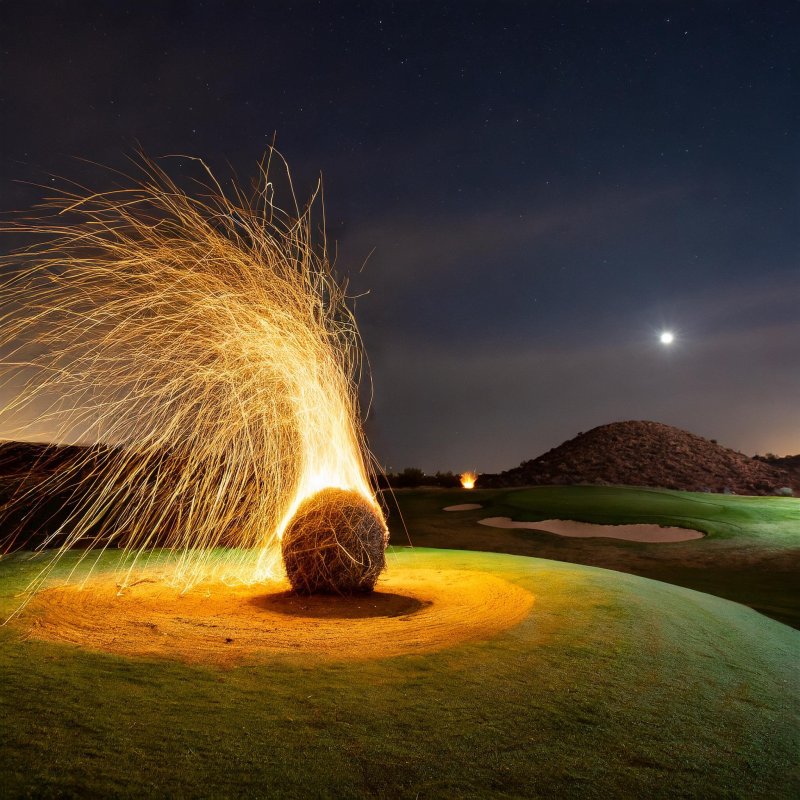Countering The Invasive Species
My first encounter with invasive species on the golf course was with the Russian Thistle, a thorny, rolling, seed-spreading bush commonly called The Tumbleweed. It happened on a raggedy 9-holer out in the barren Kettleman Hills of California, miles from nowhere. I had been left alone to manage the course while Dad tried to make the cut in some tournament.
At age 13, I could run the pro shop fairly well, clean the pool and pick the range, but I was an awful bartender. I was nervous staying alone because of that Manson bunch running around south of us. There was also the Zodiac Killer loose up north, Morro Bay (where Hitchcock shot "The Birds") was to our west, and if that wasn't enough, the clubhouse resembled the Bates Hotel . . . and it was haunted.
My first night alone, in a luxurious single-wide provided by the club, I endured a howling windstorm that rocked the trailer like a rowboat in a typhoon. When the one channel of black & white electronic TV static went off the air at midnight, I was truly alone . . . except for an unrelenting scratching at the door. Then the power went off. In full Popeye mode, I yelled, "I've stoods all I can stands and I can't stands no more!"
Launching myself out the other door, (the one with no steps) a single-shot 20 gauge in one hand and a flashlight in the other, I hit the ground awkwardly, accidentally blasted my tormentor with dove shot and lost the flashlight. In the pitch black dark, amidst all the noise of the wind, the creaking of the trailer and the hysterical whimpering, I somehow found the flashlight and discovered I had murdered a tumbleweed.
The next night I built a campfire by the first tee, a proven method to keep coyotes and haints away. As I nodded off cradling the shotgun and listening to the wind, a tumbleweed rolled in, stayed long enough to catch fire and then bounded off into the night. I watched in horror as it struck the fence by the road where quite a few tumbleweeds had already entangled themselves. Soon, they were all on fire and yearning to bounce over the fence and turn the dried out cottonfield across the road into an inferno. All I could think of was how I might knock Charley and Zodiac Guy off the front page the next day. The fence did its job with the only evidence of my special kind of stupid being a large burned patch in the rough. 
Later that year, younger brother Mike and I were left alone on the course because Dad was in second after the opening round of the LA Open. Uncle Virgil showed up to keep us from burning things, so we played golf, dark to dark. (Uncle Virgil was teaching us how to properly gamble.) It was on the 8th fairway that a huge, thorny tumbleweed attacked Virgil from behind, the thorns penetrating his doubleknits and triggering a painful, screeching wail. We probably should have warned him, but we were both two down with one to go.
We soon returned to Tennessee, where we would be safe from highly mobile danger weeds. (We didn't know about Kudzu yet.)
Kudzu can resist all forms of control except for D8.
Kudzu was far worse than Russian Thistle. Kudzu could cross a cart path overnight, chase a senior golfer and wrestle him down into the vines, never to be seen again. Kudzu can resist all forms of control except for D8. After spraying D8, we hauled the dirt to a special landfill and told them it was radioactive, rather than admit it was kudzu.
The most invasive plant we ever dealt with was the azalea. (Not the pretty native azalea, I'm referring to the tacky giant bloom version.) Our struggle began in '86, when Cruella, our Green Chairman's wife, returned from the Great April Golf Pilgrimage and shared with us her horticultic vision to take Mordor Hills Golf and Tennis Club to the next level. She arrived with a truckload of big, colorful azaleas and instructions on how to recreate #12 green from you-know-where.
I tried to tell her that azaleas only bloomed for a couple of weeks, (unless it's the plastic ones that always seem to bloom right on time) then transform into trash catchers of the helium balloon and grocery sack variety. Furthermore, cleaning out azalea beds all year for just a few weeks of color was only sensible for Great Gatsby Clubs, not courses like us with a crew of three. I suggested we go with Crepe Myrtles for color all summer.
Like most victims of A.S., Cruella's eyes turned blood red and her voice deepened, "Get busy planting my azaleas! Why don't we have more dogwoods and pine trees? Go fetch me a pimento cheese sandwich!"
If you ever find yourself in this situation, remember the teachings of the great Mark Hoban on azaleas: "Go find the biggest dumpster available and stuff them in it."
Mark also states that once those bushes have been planted, it requires a backhoe and lights to exorcise them. Oddly enough, before we could plant Cruella's azaleas, a terrible accident happened and every single plant fell in the river and washed away.


2 Comments
Recommended Comments